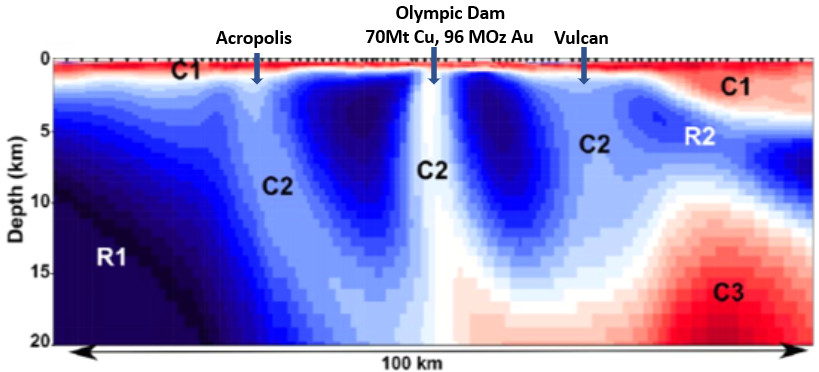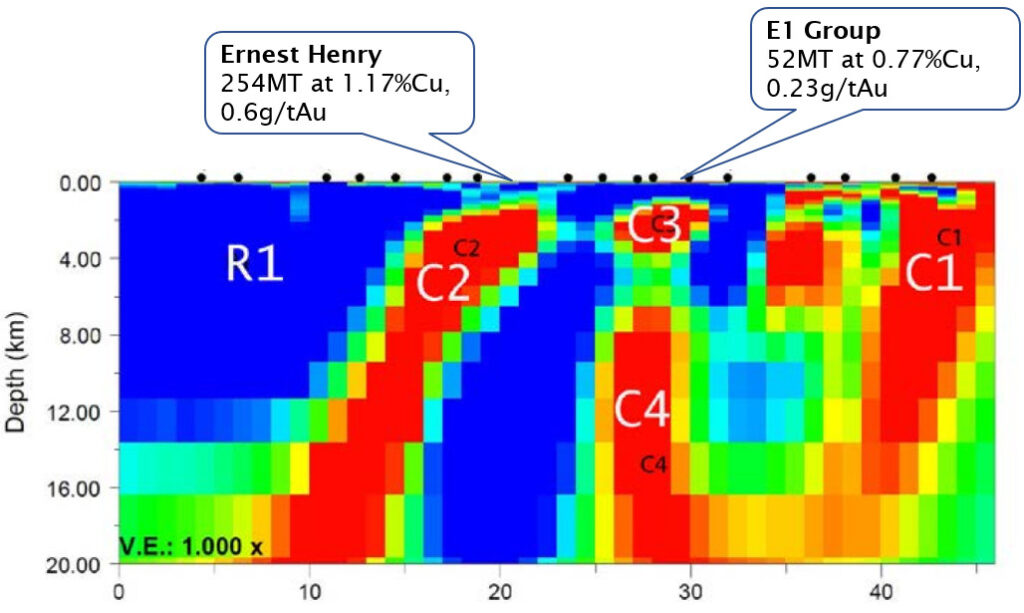
This post is a summary and review of Murphy, B., Hjuizenga, J. and Bedrosian, P., 2022. Graphite as an electrically conductive indicator of ancient crustal-scale fluid flow within mineral systems. Earth and Planetary Science Letters. https://doi.org/10.1016/j.epsl.2022.117700
Summary
- Magnetotelluric (MT) imaging has shown an apparent connection between crustal-scale electrical conductivity anomalies and major magmatic-hydrothermal iron oxide-apatite/iron oxide-copper-gold (IOA-IOCG) deposits in Australia and the United States
- The exact cause of these anomalies has been unclear
- Murphy et al (2022), interpret the conductors to be the result of graphite precipitation from CO2-rich magmatic fluids during cooling
- These fluids exsolved from mafic magmas at mid- to lower-crustal depths
- Saline magmatic fluids that could drive mineralization were likely derived from more evolved intrusions at shallower crustal levels
- The conductivity anomalies mark zones that once were the deep roots of ancient magmatic-hydrothermal mineral systems
Introduction
Magnetotelluric (MT) imaging has emerged as a key tool in the mineral systems framework, particularly due to observed spatial relationships between lithospheric-scale electrical conductivity anomalies and iron oxide-apatite and iron oxide-copper-gold deposits. The most prominent and well defined of such relationships are the Olympic Dam deposit in Southern Australia, Ernest Henry in the Cloncurry district and the Southeast Missouri Iron Province (SMIP) in the United States.
At the mineral province scale modelling of MT data produces highly-conductive steeply dipping pipe- or sheet-like anomalies at mid-lower crustal depths which evolve into moderately conductive “fingers” that extend into the upper crust beneath individual deposits.

The Proterozoic IOA-IOCG deposits in the Olympic Dam and Cloncurry regions and in the SMIP are generally believed to have a magmatic-hydrothermal origin. Genetic models invoke mantle-derived magmatism in an extensional setting providing heat and fluids and possibly metals, which fluids may have mixed with near surface fluids to drive deposit formation.

The coincident low conductivity zones both in the mid to lower crust and immediately beneath the deposits have been commonly interpreted to be the result of widespread metasomatism along crustal-scale magmatic fluid pathways. The conductors are crustal in scale, beyond the depth of physical investigation and are not exposed at the surface. North of Cloncurry the MT conductor in the mid-to lower crust covers at least 3-4,000 km2 and is coincident with the much larger Carpentaria Conductivity Anomaly.

Explanation of the Conductivity Anomalies
Various mechanism have been invoked to explain these crustal-scale conductors including free saline fluids, metallic sulphides and oxides, the thermal activation of silicate minerals, volatile mediated semiconduction in either micas or nominally anhydrous minerals (plagioclase or pyroxene), grain size reduction or graphite. Murphy et al (2022) argue that the unlikely preservation of fluids over geological timescales, transport over crustal scales or a temperature regime that is simply too cold excludes all reasonable causes excepting graphite. Their physio-chemical model offers an explanation for crustal-scale graphite deposition as veins or along grain boundaries.
Murphy et al (2022) produce a quantitative genetic physicochemical model which suggests that the anomalies are likely the result of graphite precipitation from CO2-rich magmatic fluids. They conclude that graphite will readily precipitate from a fluid with redox conditions near (within one log unit of) or below the FMQ buffer in the lower to mid crust. Under more oxidizing conditions (e.g., the modern PCD subduction environment) graphite will not precipitate.
Interestingly Murphy et al (2022) suggest a number of outcropping analogues for the MT conductors beneath Olympic Dam, Cloncurry and the SMIP. Namely the Sri Lankan vein graphite deposits which occur with a corridor 500 km long. Murphy et al (2022) argue that the volumetric ratios of graphite to country rock in the Sri Lankan graphite belt are significantly larger than generated by their model.
Conclusions
- Graphite precipitation from CO2-rich magmatically derived fluids is the best explanation for the electrical conductivity anomalies observed beneath the Olympic Dam region and the SMIP.
- Graphite will readily precipitate from carbon-bearing fluids throughout the crustal column either via cooling or via hydration reactions, under reasonable fluid redox constraints.
- Physicochemical principles upon which the model is based can be extended to other magmatic-hydrothermal mineral systems, with a source of carbon and appropriate magmatic fluid redox conditions.
- Hydrothermal graphite may be a useful electrically conductive indicator of ancient crustal-scale fluid flow and a valuable crustal-scale vector in exploring for magmatic-hydrothermal ore deposits.
It is important to note that the Murphy et al (2022) model is related to the deep crustal roots to mineral systems. The causative fluids that deposited the graphite may however not be the same fluids which carry and deposit metals and generate alteration in the near surface.
There is the strong possibility that these same fluid pathways at differing crustal levels my carry evolved magmatic, metamorphic and meteoric fluids all of which could interact to generate alteration and mineral deposits. Nevertheless, the MT conductors likely are indicative of a crustal scale tectono-magmatic system which at upper-crustal levels drives mineral deposit formation.
References
Selway, K., 2018 Developing meaningful interpretations for MT Models